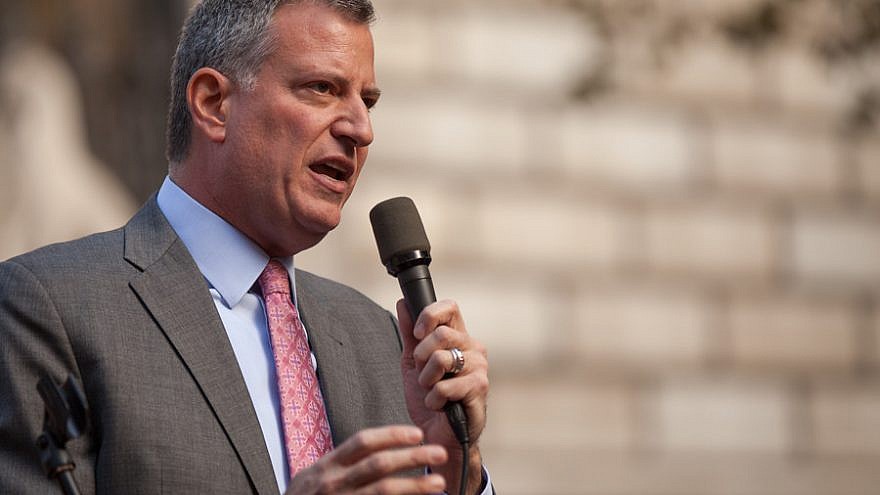New York City Mayor and Democratic presidential hopeful Bill de Blasio raised the ire of a few observers last week when he claimed that anti-Semitism is a right-wing ideology adopted by right-wing movements composed of right-wing activists.
The context for the mayor’s detour into the history of ideas was a press conference about the rise in hate crimes in New York City — a phenomenon that the haredi communities in Brooklyn have encountered dozens of times in the past two years, in incidents that have frequently involved young black men physically assaulting visibly-identifiable Jews walking alone in the late hours.
One can cite numerous reasons as to why this argument is deeply flawed — but there is something even more pressing here which has nothing to do with anything de Blasio actually said last Wednesday.
Cast your minds back to the white supremacist show of strength in Charlottesville, Va., in August 2017. Following that terrible weekend of violence — sparked by the far-right’s defense of public statues honoring confederate military commanders and slave-holders like Gen. Robert E. Lee — de Blasio announced that his administration was conducting an urgent 90-day “review of all symbols of hate on city property.”
Taking to his Twitter feed, de Blasio even saw fit to announce one of the review’s conclusions before the commissioners had begun their investigation. “The commemoration for Nazi collaborator Philippe Pétain in the Canyon of Heroes will be one of the first we remove,” he boldly asserted.
Located along a stretch of Broadway in lower Manhattan, the “Canyon of Heroes” commemorates those individuals who were honored with ticker-tape parades in New York City. One of those distinguished honorees was the French Marshal Philippe Pétain, who rode out into a snowstorm of paper on October 26, 1931 to be hailed, yet again, as the legend of the Battle of Verdun, more than a decade earlier.
Less than a decade later, Pétain had been installed as Nazi Germany’s puppet leader during the occupation of France. As head of the Vichy government, he ruthlessly applied Nazi laws to the Jews of France, culminating in the deportation of 76,000 Jews to concentration camps by his regime in 1942-43. One of Pétain’s trusted partners in that task, his “prime minister” Pierre Laval, was, curiously enough, also honored by a New York City ticker-tape parade, on October 22, 1931 — four days before Pétain himself.
In France, you won’t find a single plaque or street sign or statue honoring Pétain (or Laval), who was convicted of treason after World War II. So the absurdity of Pétain’s name being carved in silver letters along Manhattan’s best-known thoroughfare is pretty self-evident — and that is perhaps why de Blasio was willing to jump to the conclusion that the plaque would be removed.
But when the monuments commission finally released its findings in January 2018, long after its 90-day period had expired, their conclusion regarding Pétain was the exact opposite of de Blasio’s. With an equivocation that was cringe-making, when you remember that the subject under discussion was one of Hitler’s executioners, the commission stated its intention to “keep all markers memorializing ticker-tape parades in place.”
In other words, “Pétain is staying.”
The commission promised, nonetheless, to “explore opportunities to add context such as wayfinding, on-site signage, and historical information about the people for whom parades were held.” What this might involve — maybe an exhibition about the unspeakable conditions that faced thousands of Jews awaiting deportation in the “Vel d’Hiv” cycling arena in Paris in July 1942? — was not elaborated upon.
The commission’s decision on the Pétain plaque was a shameful reversal of the pledge that Mayor de Blasio volunteered with a conviction that, with hindsight, appears tastelessly opportunistic. De Blasio, after all, did not even criticize the commission’s decision, much less condemn it. When you recall that de Blasio did not mince his original words, explicitly identifying Pétain as a “Nazi collaborator,” his subsequent silence speaks even more loudly.
In de Blasio’s mind, Pétain is the avatar of a brutal, ultraconservative, privileged-white-male army general — the sort of person to whom anti-Semitism comes “naturally.” So leave aside, for a moment, de Blasio’s additional claim that the BDS movement targeting Israel is not anti-Semitic, or that there is apparently no anti-Semitism to be found on the political left or among other minorities. Leave aside, as well, the decidedly inconvenient fact that Pétain’s partner in the Vichy regime, Laval, started his political career as a socialist — as did so many others in Europe, from Mussolini to Mosely, who made the transition from the red flag to the swastika. Let us assume with de Blasio that that anti-Semitism is a disease of the right, and only the right.
Well then, Mr. Mayor, set an example and act on that knowledge. Forget about protocol and stand up to the monuments commission that you yourself appointed. As you yourself have recognized, a monument to a Nazi collaborator is by definition a monument to hate. Yet the Pétain plaque remains fixed in your own backyard, more than a year after you pledged that it would be among the first hate monuments to be removed.
If de Blasio hopes to be taken seriously when he speaks about on anti-Semitism — and more fundamentally, as a politician with a genuine moral compass — then he should address his climbdown on the Pétain plaque. Should he summon the courage on that issue that has so far eluded him, he will find himself in a much better position to dole out history lessons to the rest of us.


























